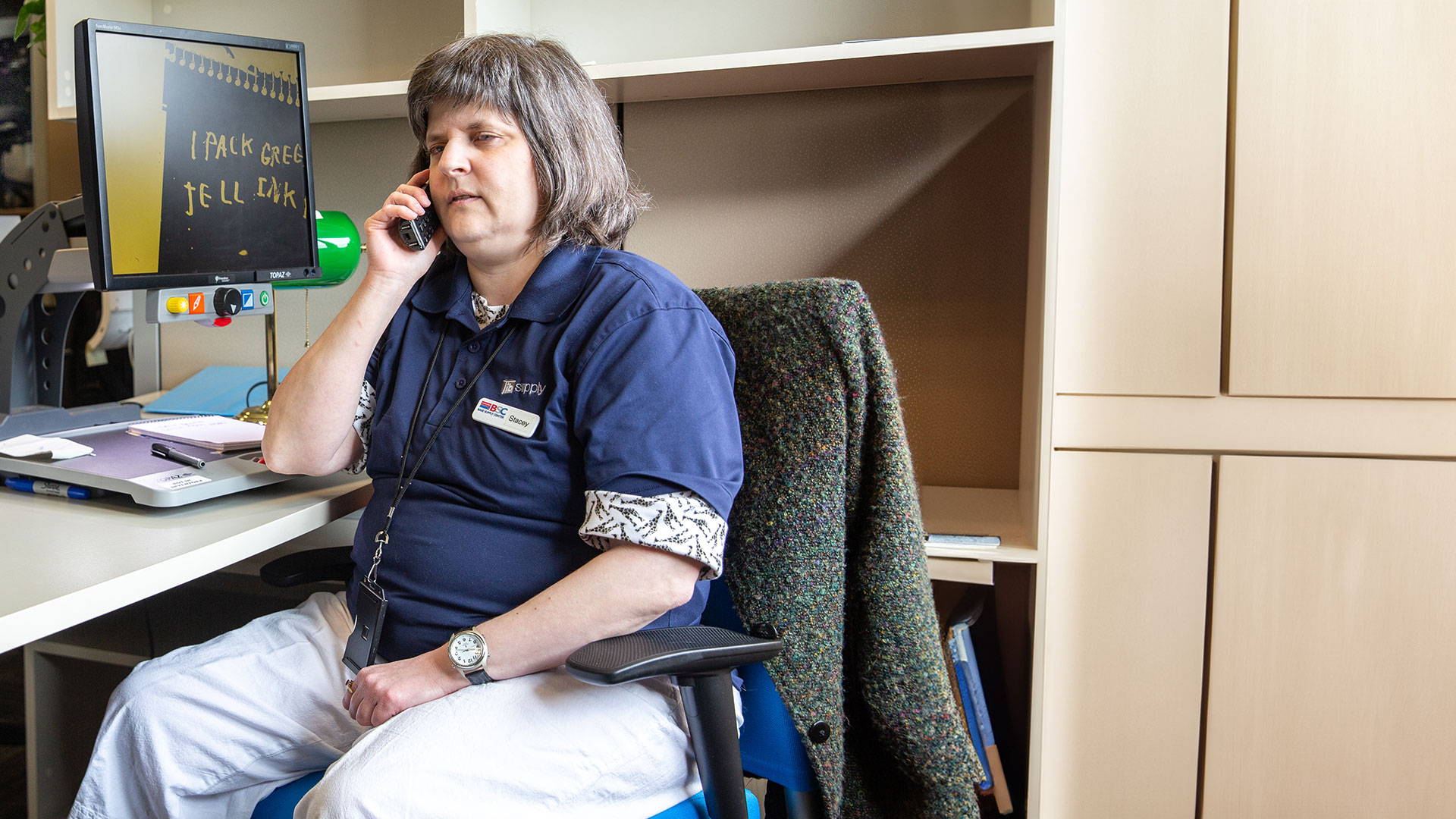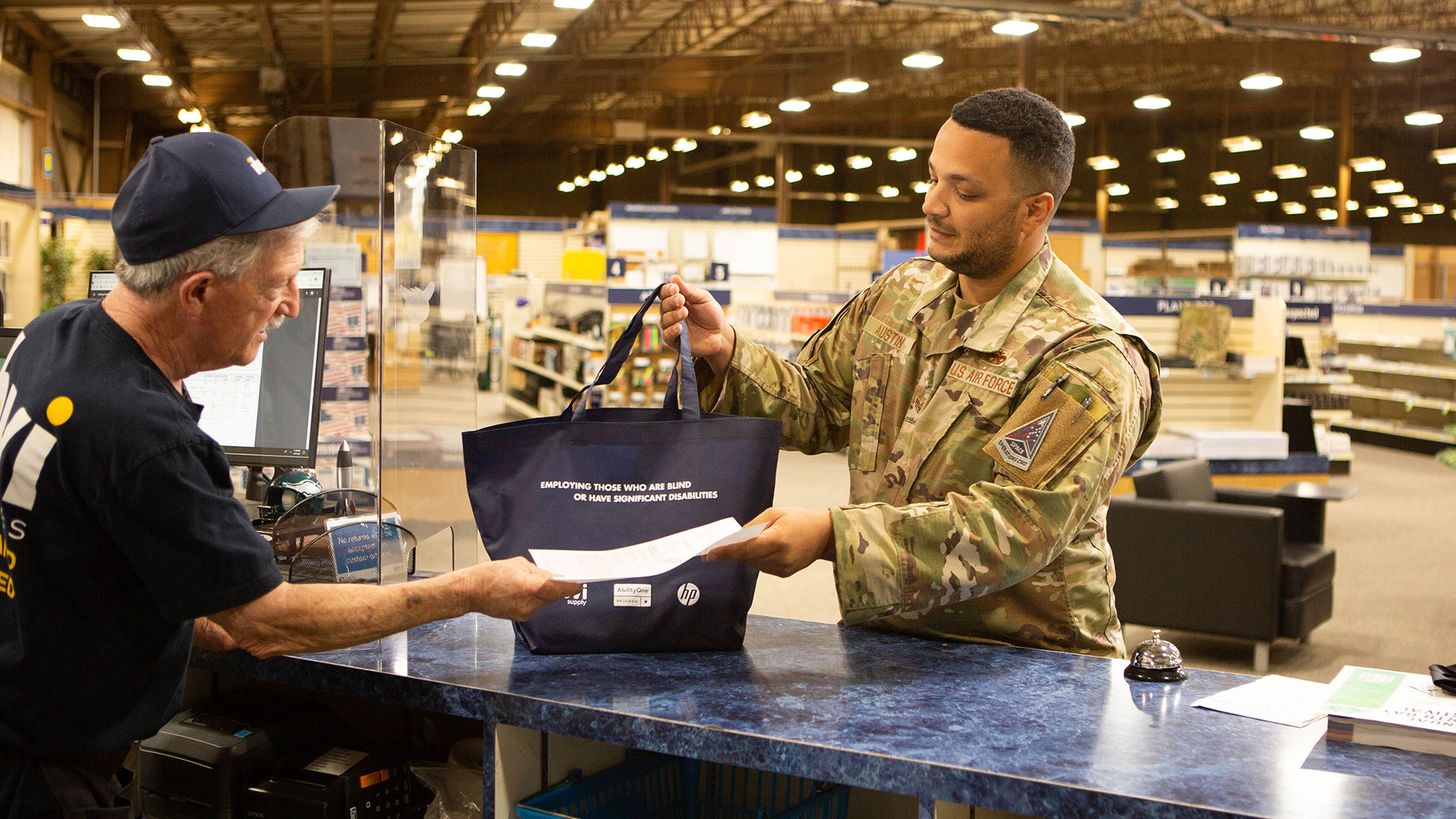February is Low Vision Awareness Month—Learn the Different Ways IBVI Uses Assistive Technology to Help Employees Succeed
Millions of Americans are living with some form of visual impairment. The term “Low vision” describes “uncorrectable vision loss that cannot improve with glasses, contact lenses, medicine, or surgery.” This low vision gets in the way of daily activities—everything from getting dressed and commuting to cooking and cleaning. In other words, people with low vision have to navigate life in a completely different way than people without visual impairment.
At IBVI, we know that low vision is not a “one size fits all”. That’s why when someone with a visual impairment joins our team, we take the time to talk through each person’s needs, so that we can understand how to best support them along the way.
Since February is Low Vision Awareness Month, we sat down with Denise Kube, Production Manager at IBVI, to highlight some of the low vision devices we use on a daily basis. We’ll also discuss how the process of applying these tools and technologies might look different from person to person.
Meeting Individual Needs
As mentioned before, the conversations begin during employee onboarding. It’s important for us to know what visual challenges each employee has and what assistance they feel most comfortable with. Once we understand that, then we’re able to match what tools we have available to best support each individual.
For the most part, this will vary depending on what their job duties will be, and what requirements exist for each position. Whether a customer service representative, product assembler, machine operator, or warehouse clerk, we have options to work with. It’s all about listening to what each person is looking for, educating them as to what’s available, and then meeting them there to provide assistance moving forward.
Advanced Tools & Technology
We provide various low vision tools and assistive technologies for our employees here at IBVI. Two of the most commonly used devices that we have come from OrCam Technologies.
- OrCam My Eye – This device attaches to the user’s glasses or is placed on a table or desk to remain stationary. It’s commonly used by management staff on their computers to read screens and charts. Additionally, it can read text out loud, verify typed information, and assist with various speech-to-text tasks.
- OrCam Read – Employees on the shop floor commonly use this handheld device. It’s just like holding a pen and with aim-and-a-click, it can read paper or electronic documents, emails, shop orders, machine quantities or counts, and more. It helps our employees perform their job tasks by providing access to information they need to see but might not be able to physically read. Once the device reads the information out loud, the user knows which tasks they’ve completed, and which
- Acrobat HD by Enhanced Vision – Through conversations, we’ve learned that some employees don’t want to use the OrCam Read or OrCam MyEye devices. Usually, this means they’re content with the other visual techs (like the Acrobat HD) we have stationed on the floors. With these, you place the camera underneath what you’d like to view, it enlarges the print, and you’re good to go. We also have zoom capabilities on our computers, and other tools to help communicate information, document it, write something down, etc.
- JAWS (Job Access With Speech) by Freedom Scientific – This helpful computer screen reader program for Microsoft Windows allows blind and visually impaired users to read the screen either with a text-to-speech output or by a refreshable Braille display.
Practice, Practice, Practice
Each of these devices are easy to use, it’s pretty much aim-and-click. It’s more a matter of getting used to the distance. Everyone’s vision is different, so it takes some time to get the feel for where the center point is for reading. It takes a little bit of practice, but once you get it, it becomes second nature. Speaking of practice, we encourage employees to take these devices home for a day or two and use them around the house to build confidence and feel more comfortable with the technology.
In doing so, some employees have learned how their bank statements or various important bills are laid out while practicing at home, so it’s great technology to use even outside of work. In fact, we’ve heard feedback like, “Oh, I was going through my mail at home…I didn’t know that monthly statement tells you all of that!” It’s a great experience to have for an individual who’s previously had to rely on someone else to read things to them, or tell them what a piece of mail says, etc. For us, helping our employees develop that sense of empowerment and independence is really what it’s all about.
Learning and Growing Together
Equally as important, we created a collaborative lab space upstairs at our West Allis facility called The Clear Room. Here, employees can learn how to use these devices and equipment as well. For some, there’s nothing like having the opportunity to ask questions in real time, while encouraging and learning alongside their co-workers. We also use this space to host classes—from teachers like Cory from Vision Forward—to help employees who want to learn different skills. These can be anything from work-related tasks to life skills or interests that provide value at home. It’s all about listening to where our employees are at, understanding their strengths and needs, then providing them with the support they need to succeed.


